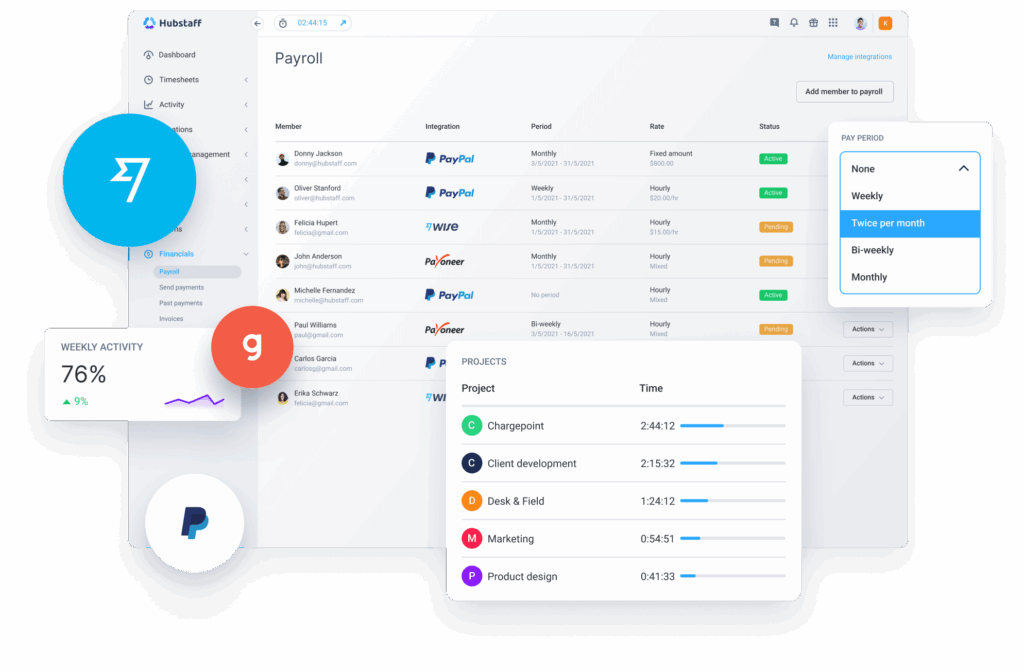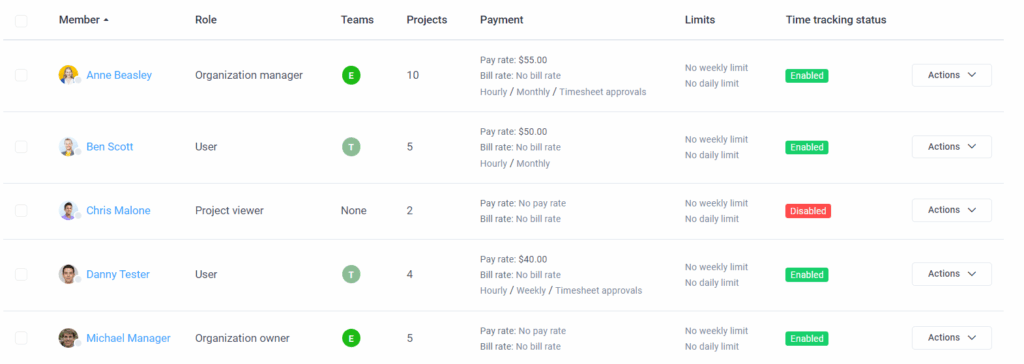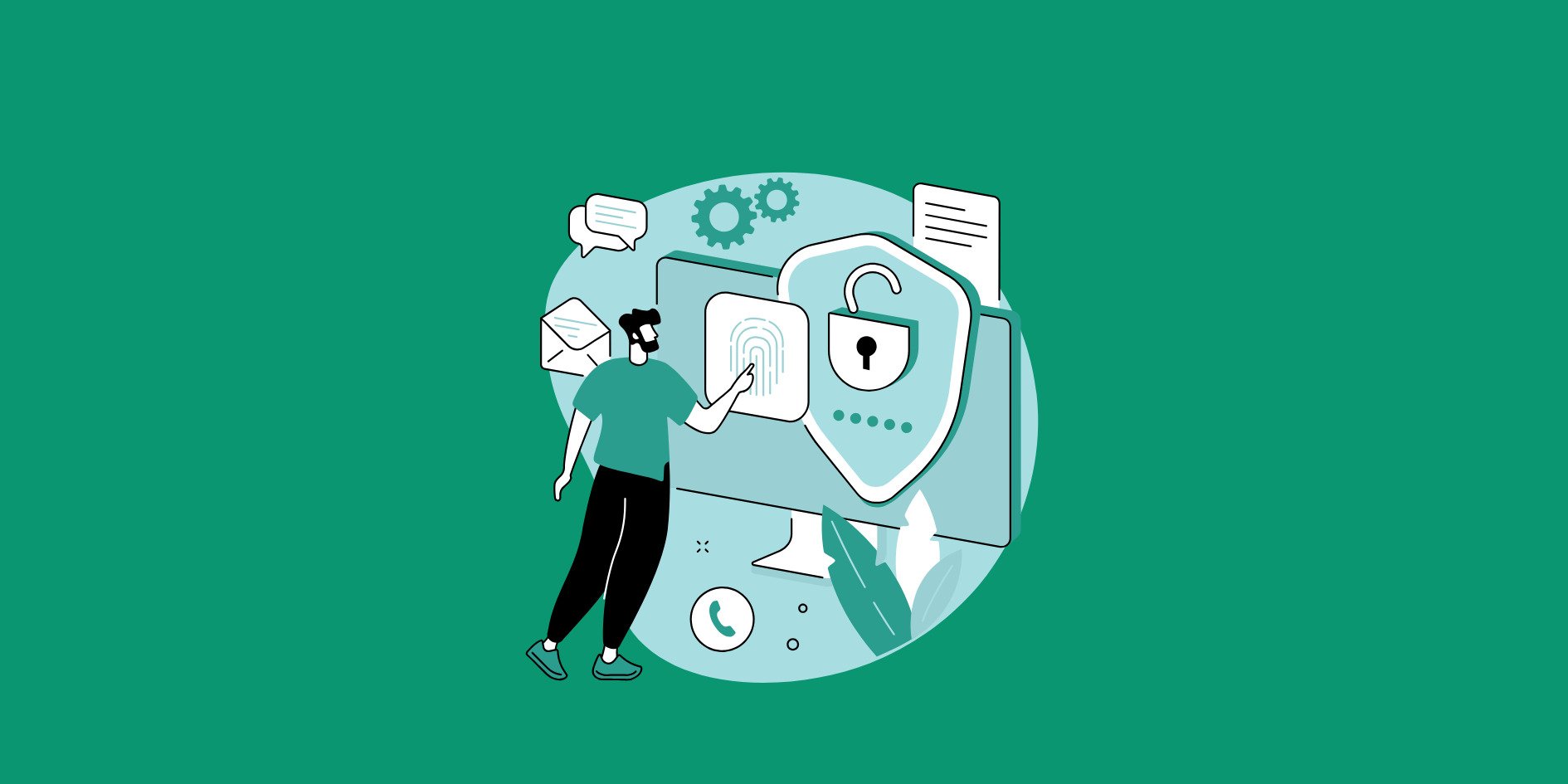Hubstaff helps teams maintain clean, verifiable records by consolidating time, activity, and payroll data into one secure system.
Whether you’re in health care, legal, finance, or another professional services field, there’s one unifying problem: audit preparation takes time. Pulling timesheets, payroll data, and activity logs from various apps results in information gaps and excessive room for error. What should be a quick verification turns into a tedious scavenger hunt.
Hubstaff takes that pressure off your team. With secure time tracking, automated payroll records, and built-in audit logs, your compliance data is always ready.
Boost your team’s efficiency with Hubstaff's productivity tools
Why audit readiness matters in regulated industries
In regulated industries, compliance isn’t optional. Every hour tracked, invoice sent, or file shared may be subject to review at a later time.
Staying audit-ready means your team can prove compliance at any time. When businesses fall short, the consequences go beyond paperwork:
- Financial penalties. Regulatory fines can cost businesses thousands, millions, or even billions of dollars for failing to maintain accurate records or violating policies.
- Reputation damage. Studies from sources like the American Accounting Association indicate that clients and partners tend to lose trust when an organization fails to meet industry standards.
- Operational setbacks. Time spent correcting mistakes or redoing reports slows down projects and drains resources.
For teams already stretched thin, meeting detailed reporting requirements is a constant challenge. Many rely on manual spreadsheets or disconnected tools, which make it difficult to maintain clean, verifiable data.
But when your business is audit-ready all year long, none of your team members have to worry about that. You save a lot of time, protect your business, and build confidence.
For more information, here are common compliance frameworks that make these expectations clear:
- HIPAA (Healthcare). HIPAA compliance mandates the strict protection of patient information and requires detailed audit trails for all access and activity.
- GDPR (Data protection). GDPR compliance requires transparency in how data is handled, stored, and shared, including verifiable user activity logs.
- Financial audits. Financial audits call for precise time and payroll records to confirm payments, billing, and internal control compliance.
Audit readiness goes beyond passing inspections or avoiding penalties. It also shows that your business is accountable and confident in its data.
Note: Compliance requirements vary by organization. Hubstaff provides features and controls that support these frameworks, but your final configuration determines whether your deployment meets specific regulatory obligations.
How Hubstaff supports audit readiness
Hubstaff provides the structure and documentation necessary to stay compliant year-round. It’s a tool built with security, transparency, and accountability in mind, so every hour tracked and every payment made can be verified with confidence.
Security-first time tracking
Hubstaff’s time tracking is built with security and data protection in mind. We align with industry frameworks such as GDPR and SOC 2 Type II, and we support HIPAA-ready deployments when used with appropriate configuration and a signed Business Associate Agreement (BAA). Data is encrypted to keep sensitive information secure, and role-based permissions help you control who can view or edit reports.
Hubstaff does not log keystrokes or capture typed content — only general activity levels (keyboard and mouse movement) to help verify work performed.
For organizations using company-managed devices, Hubstaff can run in the background without pop-ups or interruptions. This supports uninterrupted workflows while still providing accurate time and activity records, based on the permissions your administrators configure, without exposing confidential information.
For more information on how Hubstaff works from a security and compliance perspective, please review our Terms of Service and Privacy Policy.
Audit logs and activity records
Every action in Hubstaff can be traced back through detailed activity logs. These logs form an exportable audit trail that verifies time entries, project activity, and user actions whenever needed — and can be further enriched with workforce analytics data.
For organizations that need additional visibility, Hubstaff provides compliance-ready employee productivity data through features like:
- Optional screenshots
- App and URL tracking
- Activity percentages
These records make it easy to confirm who worked on what, when, and for how long without relying on manual verification.
All activity data is limited to what your organization enables. Screenshots, app tracking, or URL tracking are optional and can be disabled or blurred based on your compliance needs.
Payroll and compliance records

Time tracking is directly connected to automated timesheets. This ensures verifiable data back every logged hour. From there, you can run payroll using integrations with platforms like:
Each payment is tied to specific time entries, creating a clear paper trail for auditors. This connection between tracked time and payroll data eliminates guesswork and keeps your financial records compliant.
Flexible user management
Different teams have different oversight needs.
Hubstaff lets you control visibility and tracking preferences at the user level. This way, employees, contractors, and managers each have the right settings for their roles. Sensitive teams — such as finance, legal, or clinical staff — can be assigned more restricted configurations as needed.

Admins can apply updates or permissions in bulk with batch actions, which saves time during audits or policy changes. Instead of adjusting each profile individually, you can set settings across the team with just a few clicks.
Pulling Hubstaff reports for audits
When it’s time to prepare for an audit, Hubstaff’s reporting capabilities bring everything together. You can generate time, payroll, and activity reports in a few clicks — all pulled directly from your team’s real-time data.
1. Exporting time reports
Start with the Time and Activity Report.
This gives you a detailed breakdown of hours worked by project, client, or individual user. Each entry includes total tracked time, activity levels, and optional proof-of-work data.
You can use filters to refine the report:
- Date range: Focus on the exact audit period.
- Team members: Select specific employees or contractors.
- Projects or clients: Narrow results to a particular project, account, or department.
Once filtered, you can export the report in PDF or spreadsheet formats.
2. Reviewing payroll reports
For financial audits, the Payroll report connects tracked hours to payments. It lists the pay period, hourly rates, total payouts, and any linked integrations.
Because Hubstaff automatically ties each payment to its corresponding timesheet, auditors can trace every transaction back to verified hours. This alignment ensures that payroll records remain consistent and compliant across all systems.
3. Combining reports for complete oversight
Many teams pair time and payroll reports to show the full compliance trail, from time worked to payments processed. You can also add activity reports to confirm that logged hours align with the work performed.
For teams that need continuous oversight, combining reports with Hubstaff’s silent tracking on company-owned devices keeps accurate activity data flowing in the background. This allows teams to ensure that every record remains verifiable without interrupting daily work.
Industry use cases
Healthcare
Healthcare organizations handle sensitive data like patient records and billing information every day. Regulations like HIPAA require strict control over who can access this data and how it’s tracked.
Hubstaff supports this by keeping all time and activity information encrypted and centralized. Administrators can limit visibility via role-based permissions and maintain detailed audit logs for every access point.
When an internal or external audit occurs, exported reports show exactly who worked on what without exposing confidential patient data.
Legal services
Law firms and legal departments rely on precise timekeeping to maintain compliance and client trust. Billable hours must be verifiable — especially when used as the basis for client invoices or case audits.
Hubstaff provides this transparency with detailed time and activity reports that confirm work performed, hours logged, and activity levels. Additionally, optional screenshots and URL tracking provide an extra layer of accountability. This provides firms with they necessary documentation for audits, billing disputes, or compliance reviews.
Finance/insurance
Data integrity and traceability are non-negotiables in financial and insurance environments. Every minute of logged work and every payroll transaction has to align with regulatory requirements and internal controls.
Hubstaff keeps records consistent through automated timesheets and exportable payroll reports. Each payment, approval, and time entry is timestamped and traceable. Auditors receive a comprehensive chain of documentation, while teams can meet compliance standards without searching for scattered files.
Building trust with transparent, configurable oversight
Oversight is necessary in regulated environments, but it doesn’t have to come at the expense of trust or privacy. Hubstaff’s silent app was built for teams that need reliable activity data without interrupting daily work or creating a sense of constant surveillance.
Organizations can choose which data to collect, how it is displayed, and who has access to it — ensuring oversight that aligns with internal policies and regulatory obligations.
When enabled, the app runs quietly in the background, recording time and activity data just like the regular desktop tracker, but without pop-ups or distractions. This gives managers accurate, timestamped information for audits while allowing employees to focus on their work without interference.
The approach strikes a balance between compliance and respect for individual privacy, in line with our guiding principles. Only authorized users can access activity data, and organizations can configure what’s captured or shown based on policy requirements.
The result is visibility without micromanagement: a system that supports compliance, documentation, and accountability, while letting your team operate with autonomy.
Why Hubstaff is a compliance-ready partner
Across industries that face strict oversight, organizations use Hubstaff to maintain consistent and verifiable records.
Hubstaff pairs time tracking with features like productivity monitoring, payroll, and audit logs in one secure system to reduce the complexity of compliance. Compliance outcomes depend on your configuration. Hubstaff provides the tools — your team determines which features are appropriate for your environment.
Every record in Hubstaff can be exported and verified, including hours worked, payments made, or project activity. This transparency makes it easier to demonstrate compliance to regulators, clients, or internal auditors without piecing together data from multiple tools.
Hubstaff also follows modern security and privacy standards, including:
- Data encryption
- Access controls
- Adherence to frameworks like HIPAA and GDPR
These safeguards protect sensitive information while supporting the documentation requirements common in regulated fields.
More than a time tracker, Hubstaff acts as an operational recordkeeper for organizations that want audit readiness built into their everyday processes.
Next steps
With Hubstaff, compliance becomes second nature. With time tracking data, optional screenshots, and payroll, every record is complete and ready when you need it. Instead of pulling reports at the last minute, you always have verifiable data at hand.
The best way to see that difference is to try it yourself. Start a free trial and see how Hubstaff simplifies compliance.
Most popular
6 Signs Your Employees Can Tell They’re Being Monitored at Work
Noticing unfamiliar software, restricted access, or slower internet? These might be signs you are being monitored at work. I...
The Complete Guide to User Activity Monitoring: Tools, Benefits, and Ethics
Have you ever noticed how the conversation around monitoring tends to swing between “track everything” and “trust everyone b...
How to Choose the Right Employee Attendance Tracker for Your Team
An employee attendance tracker records time spent on the job, absences, late or abandoned shifts, and other valuable information....
How Agencies Can Leverage AI & Time Tracking to Increase Profits
Why AI Is Powering Agencies, But It’s Missing From the Data Agencies are adopting AI faster than ever – using it for research,...




